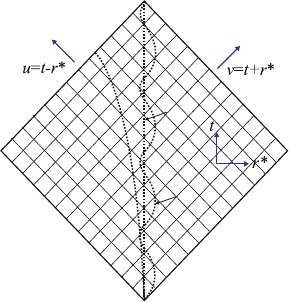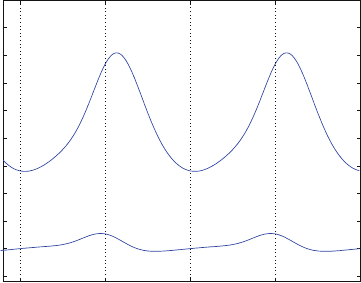Blanchet L., Spallicci A., Whiting B. (Eds.) Mass and Motion in General Relativity
Подождите немного. Документ загружается.

Computational Methods for the Self-Force in Black Hole Spacetimes 351
SF calculations we need not only
lm
but also its derivatives. Since, for example,
lm;r
is a discontinuous function of t, we will inevitably face here the well known
“Gibbs phenomenon”: the Fourier sum will fail to converge to the correct value
at r ! r
p
.t/. Of course, the problematic behavior of the Fourier sum is simply a
consequence of our attempt to reconstruct a discontinuous function as a sum over
smooth harmonics.
From a practical point of view this would mean that (i) at the coincidence limit
r ! r
p
.t/ the sum over ! modes would fail to yield the correct one-sided values
of
lm;r
,howevermany! modes are included in the sum; and (ii) if we reconstruct
lm;r
at a point r Dr
0
off the worldline, then the Fourier series should indeed for-
mally converge, however the number of ! modes required for achieving a prescribed
precision would grow unboundedly as r
0
approaches r
p
.t/, making it extremely dif-
ficult to evaluate
lm;r
at the coincidence limit.
This technical difficulty is rather generic, and will show also in calculations of
the local EM and gravitational fields. The situation is no different in the Kerr case,
because there too the mode-sum formula requires as input the spherical-harmonic
modes of the perturbation field, and for each such mode the source is represented
by a ı-distribution on a thin shell, which renders the field derivatives discontinuous
across that shell. The problem takes an even more severe form when considering EM
or gravitational perturbations via the Teukolsky formalism: Here, the l;m modes of
the perturbation fields (now the Newman–Penrose scalars) are not even continuous
at the particle’s orbit – a consequence of the fact that the source term for Teukolsky’s
equation involves derivatives of the electric four-current or the energy–momentum
tensor (a single derivative in the EM case; a second derivative in the gravitational
case). Again, a naive attempt to construct these multipoles as a sum over their !
modes will be hampered by the Gibbs phenomenon.
A simple and elegant way around the problem was proposed recently in Ref. [23].
It was shown how the desired values of the field and its derivatives at the particle can
be constructed from a sum over properly weighted homogeneous(source-free) radial
functions R
lm!
.r/, instead of the actual inhomogeneous solutions of the frequency-
domain equation. The Fourier sum of such homogeneous radial functions, which are
smooth everywhere, converges exponentially fast. The Fourier sum of the deriva-
tives, which are also smooth, is likewise exponentially convergent. The validity of
the method (and the exponential convergence) was demonstrated in Ref. [23] with
an explicit numerical calculation in the scalar-field monopole case (l D 0). It was
later implemented in a frequency-domain calculation of the monopole and dipole
modes of the Lorenz gauge metric perturbation for eccentric orbits in Schwarzschild
[13, 25, 26]. The same method should be applicable for any of the other problems
mentioned above, including the calculation of EM and gravitational perturbations
using Teukolsky’s equation.
The method of Ref. [23] (dubbed method of extended homogeneous solutions)
completely circumvents the problem of slow convergence (or the lack thereof) in
frequency-domain calculations involving point sources. It makes the frequency-
domain approach an attractive method of choice for SF calculations. The method
is now being implemented in first calculations of the scalar-field SF for Kerr or-
bits [119].

352 L. Barack
4 An Example: Gravitational Self-Force in Schwarzschild Via
1C1D Evolution in Lorenz Gauge
As an example of a fully worked out calculation of the SF, we review here the work
by Barack and Sago on eccentric geodesic in Schwarzschild [24, 26]. This work
represents a direct implementation of the mode-sum formula in its original form
(20). The decomposed Lorenz-gauge metric perturbation equations are integrated
directly using numerical evolution in 1C1D. The numerical algorithm employs a
straightforward fourth-order-convergent finite-difference scheme (using a version
of the Lousto–Price method) on a staggered numerical mesh based on characteris-
tic coordinates. Below we briefly describe the perturbation formalism, discuss the
numerical implementation in some more detail, and present some results.
4.1 Lorenz-Gauge Formulation
The linearized Einstein equation in the Lorenz gauge takes the form
N
h
˛ˇ
C 2R
˛
ˇ
N
h
D16T
˛ˇ
; (43)
where
N
h
is the trace-reversed metric perturbation (Eq. 1), is the covari-
ant D’Alembertian operator, R
˛ˇ ı
is the Riemann tensor of the background
spacetime, and T
˛ˇ
in the source’s energy–momentum tensor. For a point par-
ticle of mass moving on a timelike geodesic x
p
./, the latter is modeled as
T
˛ˇ
.x
/ D
Z
1
1
.g/
1=2
ı
4
Œx
x
p
./u
˛
u
ˇ
d; (44)
where g is the background metric’s determinant and u
˛
in the particle’s four-
velocity. Eq. 43 is a linear, diagonal hyperbolic system, which admits a well-posed
initial-value formulation on a spacelike Cauchy hypersurface (see, e.g., Theorem
10.1.2 of [118]). Furthermore, if the gauge conditions (Eq. 1) are satisfied on the
initial Cauchy surface, then they are guaranteed to hold everywhere (assuming that
Eq. 43 is satisfied everywhere and that T
˛ˇ
Iˇ
D 0, as in our case).
6
We now specialize to eccentric geodesics around a Schwarzschild black hole,
and employ a Schwarzschild coordinate system (t;r;;') in which the orbit is
equatorial (
p
D =2). Such orbits constitute a two-parameter family; we may
characterize each orbit by the radial “turning points” r
min
and r
max
, or alterna-
tively by the “semi-latus rectum” p 2.r
max
r
min
/=.r
max
C r
min
/ and “eccentricity”
e .r
max
r
min
/=.r
max
C r
min
/.
6
The gauge conditions (1) do not fully specify the gauge: There is a residual gauge freedom within
the family of Lorenz gauges, h
˛ˇ
! h
˛ˇ
C
˛Iˇ
C
ˇI˛
, with any
satisfying
D 0.Itis
easy to verify that both Eqs. 1 and 43 remain invariant under such gauge transformations.

Computational Methods for the Self-Force in Black Hole Spacetimes 353
Barack and Lousto [15] decomposed the metric perturbation into tensor
harmonics, in the form
N
h
˛ˇ
D
r
X
l;m
10
X
iD1
N
h
.i/lm
.r; t / Y
.i/lm
˛ˇ
.; '/; (45)
and similarly for the source T
˛ˇ
. The harmonics Y
.i/lm
˛ˇ
.; '/ (whose components
are constructed from ordinary spherical harmonics and their first and second deriva-
tives) form a complete orthogonal basis for second-rank covariant tensors on a
2-sphere (see Appendix A of [15]). The time-radial functions
N
h
.i/lm
(i D 1;:::;10)
form our basic set of perturbation fields, and serve as variables for the numerical
evolution.
7
The tensor-harmonic decomposition decouples Eq. 43 with respect to
l;m, although not with respect to i: For each l;m,thevariables
N
h
.i/lm
satisfy a cou-
pled set of hyperbolic (in a 1+1D sense) scalar-like equations, which may be written
in the form
.2/
N
h
.i/lm
C M
.i/l
.j /
N
h
.j /lm
D S
.i/lm
.i D 1; : : : ; 10/: (46)
Here
.2/
is the 1+1D scalar field wave operator @
2
uv
C V.r/,wherev and u are the
standard Eddington–Finkelsteinnull coordinates, and V.r/D
1
4
.12M=r/
2M=r
3
Cl.l C 1/=r
2
is an effective potential. The “coupling” terms M
.i/l
.j /
N
h
.j /lm
involve
first derivatives of the
N
h
.j /lm
’s at most (no second derivatives), so that, conveniently,
the set (46) decouples at its principal part. The decoupled source terms S
.i/lm
are
each / ıŒr r
p
./ (no derivatives of ı function) and, as a result, the physical
solutions
N
h
.j /lm
are continuous even at the particle. Explicit expressions for the
coupling terms and the source terms in Eq. 46 can be found in Ref. [15].
In addition to the evolution equations (46), the functions
N
h
.i/lm
also satisfy
four first-order elliptic equations, which arise from the separation of the gauge
conditions (1)intol;m modes. In the continuum initial-value problem, the solu-
tions
N
h
.i/lm
satisfy these “constraints” automatically if only they satisfy them on
the initial Cauchy surface. This is more difficult to guarantee in a finite-difference
treatment, where (i) it is often impossible to prescribe exact initial data that satisfy
the constraints, and (ii) discretization errors may amplify constraint violations over
the evolution. Inspired by a remedy proposed for a similar problem in the context
of nonlinear Numerical Relativity [58], Ref. [15] proposed the inclusion of “diver-
gence dissipation” terms, / h
Iˇ
˛ˇ
, in the original set (43), so designed to guarantee
that any violations of the Lorenz-gauge conditions are efficiently damped during
the evolution. These damping terms modify only the explicit form of the M terms
in Eq. 46 as shown in [15].
7
To simplify the appearance of Eq. 45 we have used here a slightly different normalization than
that of [15] for the functions
N
h
.i/lm
.

354 L. Barack
4.2 Numerical Implementation
The code developed by Barack and Sago [24, 26] solves the coupled set (46)
(with constraint dissipation terms incorporated in the M terms) via time evolution.
The numerical domain, covering a portion of the external Schwarzschild geome-
try, is depicted in Fig. 3. The numerical grid is based on Eddington–Finkelstein
null coordinates v; u, and initial data (the values of the 10 fields
N
h
.i/lm
for each
l;m) are specified on two characteristic initial surfaces v D const and u D const.
Equations 46 are then discretized on this grid using a finite-difference algorithm
which is globally fourth-order convergent. The numerical integrator solves for the
various
N
h
.i/lm
’s along consecutive v D const rays. A particularly convenient fea-
ture of this setup is that no boundary conditions need be specified (the characteristic
grid has no causal boundaries). Moreover, one need not be at all concerned with
the determination of faithful initial conditions: It is sufficient to set
N
h
.i/lm
D 0 on
the initial surfaces and simply let the resulting spurious radiation (which emanate
from the intersection of the particle’s worldline with the initial surface) dissipate
away over the evolution time. The early part of the evolution, which is typically
dominated by such spurious radiation, is simply discarded.
The conservative modes l D0 and l D1 (the monopole and dipole, respectively)
require a separate treatment, as they do not evolve stably using the above numeri-
cal scheme. (A naive attempt to evolve these modes leads to numerical instabilities
which, so far, could not be cured.) Fortunately, the set (46) simplifies considerably
for these modes, and solutions can be obtained in a semi-analytic manner based
on physical considerations. Detweiler and Poisson [43] worked out the l D0; 1
Lorenz-gauge solutions for circular orbits, and their work is generalized to eccentric
orbits in Ref. [13], relying on the aforementioned method of extended homogeneous
solutions. The calculation of [13] yields the values of the fields
N
h
.i/lm
and their
derivatives for l D0; 1.
“Event
Horizon”
Initial surface
“Null
Infinity”
Initial surface
Plunge
Circular
Eccentric
Fig. 3 The numerical 1C1D domain in the Barack–Sago code [24, 26]: A staggered mesh
based on characteristic (Eddington–Finkelstein) coordinates v; u. t and r
are, respectively, the
Schwarzschild time and tortoise radial coordinates. The evolution proceeds from characteristic ini-
tial data on two null surfaces. Illustrated are a few sample geodesic orbits (radial plunge, circular,
eccentric)

Computational Methods for the Self-Force in Black Hole Spacetimes 355
−0.5 0 0.5 1 1.5
−0.005
0
0.005
0.01
0.015
0.02
0.025
0.03
0.035
0.04
0.045
Radial phase / (2π)
F
r
p = 7.0 M
e = 0.2
F
t
Fig. 4 The gravitational SF [in units of .=M /
2
] along a Schwarzschild geodesic with semi-latus
rectum p D 7M and eccentricity e D 0:2. The upper and lower graphs show F
r
self
and F
self
t
,
respectively. Integer values on the horizontal axis correspond to periapses (r D r
min
)
To construct the l modes F
˛l
˙
[the necessary input for the mode-sum formula
(20)], one first substitutes the expansion (45) in the expression for the full force F
˛
(left-hand expression in Eq. 9), and then formally expands the result in spherical
harmonics. The outcome is a formula for F
˛l
˙
given in terms of the various fields
N
h
.i/l
0
m
and their derivatives (evaluated at the particle and summed over m), where, if
the fixed-k extension is used, one finds in general l 3 l
0
l C3. One then uses
the numerical values of the fields
N
h
.i/lm
and their derivatives, as calculated along
the orbit using the above code, to construct F
˛l
˙
for sufficiently many l modes. The
mode-sum formula (20) then gives the SF. Figure 4 shows the final result for an
eccentric geodesic with p D 7M and e D 0:2.
The calculation we have just described represents a milestone in the SF program:
We now finally have a code capable of tackling the generic EMRI-relevant SF prob-
lem in Schwarzschild. (Indeed, to address the fully generic physical problem would
require a final generalization to the Kerr case!) Using this code, and similar codes
developed independently by others [42], we can now begin to explore the physical
consequences of the gravitational SF – particularly those effects associated with its
conservative piece. Work done so far includes (i) study of gauge invariant SF effects
on circular orbits [42], (ii) comparison of SF calculations and results from PN the-
ory in the weak field regime [42,109], (iii) comparison of SF results from different
calculation schemes and using different gauges [109], and (iv) a calculation of the
shift in the last stable circular orbit (and its frequency) due to the conservative piece
of the SF [25]. Work is in progress to calculate SF-related precessional effects for
eccentric orbits.

356 L. Barack
5 Toward Self-Force Calculations in Kerr: the Puncture
Method and m-Mode Regularization
The time-domain Lorenz-gauge treatment of Section 4 relies crucially on the separa-
bility of the field equations into (tensorial) spherical harmonics, which is no longer
possible in Kerr. In the Kerr problem one can at best separate the metric perturbation
equations into azimuthal m modes, using the substitution
8
N
h
˛ˇ
D
1
X
mD1
N
h
m
˛ˇ
.t;r;/e
im'
: (47)
Then one faces solving the coupled set for the 2C1D variables
N
h
m
˛ˇ
. This, nowadays,
is easily within the capability of even a standard desktop computer; indeed, over the
past decade, 2C1D numerical evolution has been a method of choice in many studies
of Kerr perturbations [11, 71–74,77,95,112]. Alas, the introduction of a ı-function
source in a 2C1D evolution is problematic, since the variables
N
h
m
˛ˇ
then suffer a
singularity near the particle. The puncture method, which we have mentioned briefly
in Section 3.2, overcomes this technical difficulty. In this section we review this
method (as implemented by Barack and Golbourn [11]) in some more detail. We
also describe a new, ad hoc, regularization method – the m-mode regularization
scheme – which enables a straightforward construction of the SF directly from the
2C1D numerical solutions, without resorting to a multipole decomposition.
5.1 Puncture Method in 2C1D
In Section 1 we have split the (trace-reversed) metric perturbation as
N
h
˛ˇ
D
N
h
S
˛ˇ
C
N
h
R
˛ˇ
, with the gravitational SF then obtained from the smooth field
N
h
R
˛ˇ
as prescribed
in Eq. 4. Here we introduce a new splitting,
N
h
˛ˇ
D
N
h
S
˛ˇ
C
N
h
R
˛ˇ
D
N
h
punc
˛ˇ
C
N
h
res
˛ˇ
; (48)
so that
N
h
R
˛ˇ
D
N
h
res
˛ˇ
C .
N
h
punc
˛ˇ
N
h
S
˛ˇ
/: (49)
We denote the m modes of these various quantities, defined as in Eq. 47,by
N
h
R;m
˛ˇ
,
N
h
res;m
˛ˇ
, etc. The new splitting is defined (in a nonunique way) by devising a puncture
8
A full separation of variables in Kerr is possible within Teukolsky’s formalism, which, alas, brings
about the metric reconstruction and gauge-related difficulties discussed in previous chapters. A full
separation of the metric perturbation equations themselves, in Kerr, has not been formulated yet,
to the best of our knowledge.

Computational Methods for the Self-Force in Black Hole Spacetimes 357
field
N
h
punc
˛ˇ
, given analytically, which approximates
N
h
S
˛ˇ
near the particle well enough
that the m modes of the resulting residual field
N
h
res
˛ˇ
are continuous and differentiable
along the particle’s worldline (and anywhere else). A particular such puncture is pre-
scribed below (Eq. 56). The form of the puncture function away from the particle can
be chosen as convenient; for example, in such a way that it can be decomposed into
m modes explicitly, in analytic form (as in Ref. [11], for a scalar-field toy model).
The Lorenz-gauge perturbation equations (43) are now written in the form
N
h
res
˛ˇ
C 2R
˛
ˇ
N
h
res
D S
res
˛ˇ
; (50)
with
S
res
˛ˇ
16T
˛ˇ
N
h
punc
˛ˇ
2R
˛
ˇ
N
h
punc
: (51)
The support of the source S
res
˛ˇ
now extends beyond the particle’s worldline, but it
contains no ı function on the worldline.
9
The equations are separated into m modes,
with the m-mode source given by
S
res;m
˛ˇ
.t;r;/
1
2
Z
S
res
˛ˇ
.t;r;;'/e
im'
d': (52)
If the puncture is sufficiently simple, the source S
res;m
˛ˇ
can be evaluated in closed
form (as in [11]). The m-mode field equations for the variables
N
h
res;m
˛ˇ
.t;r;/,which
are everywhere continuous and differentiable, can now be integrated numerically
using straightforward finite differentiation on a 2C1D grid.
To ease the imposition of boundary conditions for
N
h
res;m
˛ˇ
, it is convenient to sup-
press the support of the puncture
N
h
punc
˛ˇ
away from the particle, so that the physical
boundary conditions for
N
h
res
˛ˇ
become practically identical to that of the full re-
tarded field
N
h
˛ˇ
.In[11] this is achieved in a simple way by introducing an auxiliary
“worldtube” around the particle’s worldline (in the 2C1D space): Inside this world-
tube one solves the “punctured” m-mode equations for
N
h
res;m
˛ˇ
, while outside the
worldtube one uses the original, retarded-field m-modes
N
h
m
˛ˇ
as evolution variables;
the value of the evolution variables is adjusted on the boundary of the worldtube
using
N
h
m
˛ˇ
D
N
h
res;m
˛ˇ
C
N
h
punc;m
˛ˇ
.
Two very similar variants of the puncture scheme have been developed and im-
plemented independently by two groups [11,77] – both for the toy model of a scalar
charge on a circular orbit around a Schwarzschild black hole (refraining from a
spherical harmonics decomposition and instead working in 2C1D). The method is
yet to be applied to Kerr and to gravitational perturbations.
9
This can be shown by integrating S
res
˛ˇ
over a small 3-ball containing the particle (at a given time),
and then inspecting the limit as the radius of the ball tends to zero [11].

358 L. Barack
5.2 m-Mode Regularization
The 2C1D numerical solutions obtained using the puncture method can be used
to construct the input modes F
˛l
˙
for the mode-sum formula (20), but this would
require the additional step of a decomposition in spherical harmonics. It appears,
however, that there is a simple way to construct the SF directly from the residual
modes
N
h
res;m
˛ˇ
, without resorting to a multipole decomposition. Such “m-mode reg-
ularization” procedure was prescribed recently in Ref. [12] for the scalar, EM, and
gravitational SFs. We describe it here as applied to the gravitational SF.
In analogy with Eq. 9, let us define the “force” fields
F
˛
res
.x/ D k
˛ˇ ı
N
h
res
ˇIı
;F
˛
punc
.x/ D k
˛ˇ ı
N
h
punc
ˇIı
: (53)
Then, recalling Eqs. 4 and 49, we may write the SF at a point z along the orbit as
F
˛
self
.z/ D lim
x!z
h
F
˛
res
.x/ C
F
˛
punc
.x/ F
˛
S
.x/
i
: (54)
Recall that the expression in square brackets (D k
˛ˇ ı
N
h
R
ˇIı
) is a smooth (ana-
lytic) function of x, and so the limit x ! z is well defined.
Now consider a particular puncture function, prescribed as follows. For an arbi-
trary spacetime point x outside the black hole, let ˙
x
be the spatial hypersurface t D
const containing x,letN.t/ be the value of at which ˙
x
intersects the particle’s
worldline, and denote Nz.t/ zŒN.t/ and Nu
˛
u
˛
.Nz/. For given x define the coordi-
nate distance ıx
˛
x
˛
Nz
˛
.t/ [with Boyer–Lindquist components .0;ır;ı;ı'/],
and construct the three quantities
N
S
0
,
N
S
1
,andı Nu
˛
defined just as S
0
, S
1
,andıu
˛
in
Eqs. 23–25, with z replaced by Nz.Forjıxjvery small,thesum
N
S
0
C
N
S
1
approximates
the squared geodesic distance from x to the worldline, and Nu
˛
.z/Cı Nu
˛
approximates
the four-velocity Ou
˛
parallelly propagated from Nz to x:
N
S
0
C
N
S
1
D
2
C O.ıx
4
/; Nu
˛
C ı Nu
˛
DOu
˛
C O.ıx
2
/ (55)
(recall Eq. 22). We emphasize, however, that here the quantities
N
S
0
,
N
S
1
,andı Nu
˛
are given globally, in closed form, for any x outside the black hole. The puncture
function we wish to consider is given, for any x,by
N
h
punc
˛ˇ
.x/ D
4
Nu
˛
Nu
ˇ
C ı Nu
˛
Nu
ˇ
CNu
˛
ı Nu
ˇ
.
N
S
0
C
N
S
1
/
1=2
: (56)
This function can be attenuated far from the particle in order to control its global
properties, but such modifications will not affect our discussion here.
We now recall the form of the “physical” singular field
N
h
S
˛ˇ
expressed in Eq. 5.
This expression applies to any nearby points z and x, but here we wish to apply it
with x being a given point near the worldline and z DNz.t/ being the associated

Computational Methods for the Self-Force in Black Hole Spacetimes 359
worldline point on ˙
x
. It is not difficult to show [12] that, near the particle, the
difference between the puncture (56) and the S field has the form
N
h
punc
˛ˇ
N
h
S
˛ˇ
DN
3
0
P
.4/
˛ˇ
.ıx/ C const C O.ıx
2
/; (57)
where N
0
N
S
1=2
0
,andP
.4/
˛ˇ
is a smooth function of the coordinate differences ıx
˛
,
of homogeneous order .ıx/
4
. It follows that the difference between the correspond-
ing force fields has the local form
F
˛
punc
.x/ F
˛
S
.x/ DN
5
0
P
˛
.5/
.ıx/ C O.ıx/ (58)
(for any smooth k-extension), where P
˛
.5/
is yet another smooth function, now of
homogeneous order .ıx/
5
. Notice that F
˛
punc
F
˛
S
is bounded but generally discon-
tinuous (direction dependent) at x !Nz.FromEq.54 it then follows that F
˛
res
too
is bounded but discontinuous at x !Nz [since the limit of the entire expression in
square brackets in (54) is known to be definite].
We now arrive at the crucial step of our discussion. In Eq. 54, for a given point z
along the particle’s worldline, we express the (analytic) function in square brackets
as a formal sum over m modes, in the form
F
˛
self
.z/ D lim
x!z
1
X
mD1
h
F
˛;m
res
.x/ C
F
˛;m
punc
.x/ F
˛;m
S
.x/
i
; (59)
where
F
˛;m
res
.x/
1
2
Z
F
˛
res
.t;r; '
0
INz/e
im.''
0
/
d'
0
; (60)
and similarly for F
˛;m
punc
and F
˛;m
S
. Since the m-mode sum is formally a Fourier
expansion, and since the Fourier expansion of an analytic function converges uni-
formly, we may replace the order of limit and summation in Eq. 59:
F
˛
self
.z/ D
1
X
mD1
lim
x!z
h
F
˛;m
res
.x/ C
F
˛;m
punc
.x/ F
˛;m
S
.x/
i
: (61)
From Eq. 58, omitting the terms O.ıx/ as they cannot possibly affect the final value
of the SF in Eq. 54,wehave
lim
x!z
F
˛;m
punc
F
˛;m
S
D lim
x!Nz
1
2
e
im'
Z
N
5
0
P
˛
.5/
e
im'
0
d'
0
; (62)
where the integrand is evaluated at ' D '
0
and where we have used the fact that
x ! z implies also x !Nz. Crucially, one finds [12] that the last integral vanishes at

360 L. Barack
the limit x !Nz,foranym, regardless of the explicit form of P
˛
.5/
.
10
Hence, Eq. 61
reduces to
F
˛
self
.z/ D
1
X
mD1
F
˛;m
res
.z/: (63)
Here the substitution x D z is allowed since the limit x ! z is known to be well
defined (and, in particular, direction independent). Phrased differently, the modes
F
˛;m
res
corresponding to our puncture (56) are continuous at the particle, as desired.
Our result (63) can be written explicitly in terms of the m modes of the residual
field
N
h
res
ˇ
, and easily so if we use the fixed-k extension introduced in Section 2.3
(the choice of k-extension may affect the value of the individual m modes, but not
the eventual value of the SF). We then have
F
˛
self
D
1
X
mD1
k
˛ˇ ı
N
h
res;m
ˇ
e
im'
Iı
; (64)
where, of course, the derivatives are evaluated at the particle.
Equation 64 prescribes an extremely simple algorithm for constructing the SF
in a 2C1D framework. In the puncture scheme we effectively “regularize” the field
equations themselves (not their solutions, as in the standard l-mode regularization
method), by writing them in the form (50) with a sufficiently accurate puncture func-
tion (like the one prescribed in 56). Once the m modes of the residual perturbation
have been solved for, the SF is constructed directly from these mode with no further
regularization needed.
The m-mode method is yet to be applied in actual calculations of the SF. It has
the potential of providing a robust, simple, and efficient framework for calculations
of the gravitational SF in Kerr spacetime.
6 Reflections and Prospects
We have attempted here to give a snapshot of the activity surrounding the devel-
opment of reliable, efficient, and accurate computational methods for the SF in
black hole spacetimes. The problem still attracts considerable attention (more than
half of the papers on our reference list date 2005), with a multitude of differ-
ent approaches being studied by different groups. This multitude is, of course, a
great blessing, as it offers the opportunity for cross-validation of techniques and
10
It should not come as a surprise that at x D z the sum over m-modes F
˛;m
punc
F
˛;m
S
(which are all
zero) fails to recover the original function F
˛
punc
F
˛
S
(which is discontinuous and hence indefinite).
Recall that the formal Fourier sum at a step discontinuity (where the function itself is indefinite) is
in fact convergent: it yields the two-side average value of the function at the discontinuity. Techni-
cally, this peculiarity of the formal Fourier expansion is due simply to the noninterchangeability of
the sum and limit at the point of discontinuity.
